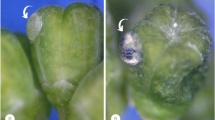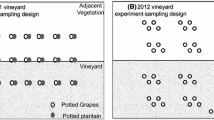Abstract
During a survey for natural enemies of thegrape berry moth (GBM) Endopiza viteana(Clemens) in northwestern Pennsylvania, wefound that Trichogramma minutum Riley isthe only native egg parasitoid with thepotential to limit berry damage by preventingegg hatch. Natural parasitism, however, wasfound to be unreliable for providing economicpest suppression. Early season populations ofthe parasitoid are extremely low and may be theresult of inadequate alternative host eggs foroverwintering. Also, wild grapes and theirwooded habitats were found to be favored byT. minutum. Parasitism was low incultivated grapes and in wild grapes growingclose to commercial vineyards (possibly due tothe deterrent effect of insecticides) andhighest in sites ≈1.5 km from commercialvineyards. Adult T. minutum emergingfrom GBM eggs were exceptionally small andshowed little vigor. Parasitized eggs oftenfailed to produce adult parasitoids. Pre-adults in such eggs had poorly formed mouth-parts or lacked them altogether. Inundativereleases of laboratory-reared T. minutumin border rows of vineyards are suggested as apossible alternative to the current practice ofapplying carbamate and organophosphateinsecticides, which are inimical to beneficialarthropods.
Similar content being viewed by others
References
Agresti, A., 1990. An introduction to categorical data analysis. John Wiley and Sons, New York.
Altieri, M.A. and W.H. Whitcomb, 1979. The potential use of weeds in the manipulation of beneficial insects. Hort. Sci. 14: 12–18.
Altieri, M.A., W.J. Lewis, D.A. Nordlund, R.C. Gueldner and J.W. Todd, 1981. Chemical interactions between plants and Trichogramma wasps in Georgia soybean fields. Prot. Ecol. 3: 259–263.
Bai, B., R.F. Luck, L. Foster, B. Stephens and J.A.M. Janssen, 1992. The effect of host size on quality attributes of the egg parasitoid, Trichogramma pretiosum. Entomol. Exp. Appl. 64: 37–48.
Bai, B.B. and S.M. Smith, 1994. Patterns of host exploitation by their parasitoid wasp T. minutum (Hymenoptera: Trichogrammatidae) when attacking eggs of the spruce budworm (Lepidoptera: Tortricidae) in Canadian forests. Ann. Entomol. Soc. Am. 87: 546–553.
Bigler, F.,M. Bieri, A. Fritschy and K. Seidel, 1988. Variation in locomotion between laboratory strains of Trichogramma maidis and its impact on parasitization of eggs of Ostrinia nubilalis in the field. Entomol. Exp. Appl. 49: 283–290.
Dozier, H.L., L.L. Williams and H.G. Butler, 1932. Life history of grape berry moth in Delaware. Delaware Agr. Exp. Sta. Bull. 176: 147.
Flanders, S.E., 1968. The validity of Trichogramma pretiosum. Ann. Entomol. Soc. Am. 61: 1122–1124.
Gleissner, B.D., 1943. Biology and control of berry moth in the Erie grape belt. Bull. 451, Agric. Exp. Sta., Pennsylvania State College. pp. 74.
Hassell, M.E., 1971. Mutual interference between searching insect parasitoids. J. Anim. Ecol. 40: 473–486.
Hoffman, C.J. and T.J. Dennehy, 1987. Assessing the risk of grape berry moth attack in New York vineyards. New York's Food and Life Sciences Bull. 120: 1–4.
Houseweart, M.W., D.T. Jennings, S.H. Pease and R.K. Lawrence, 1984. Alternate insect hosts and characteristics of forest stands supporting native populations of Trichogramma minutum Riley. Misc. Report. no. 300, Univ. of Maine. pp. 32.
Kazmer, D.J. and R.F. Luck, 1995. Field tests of the size-fitness hypothesis in the egg parasitoid Trichogramma pretiosum. Ecology 76: 412–425.
Krombein, K.V., E.D. Hurd, D.R. Smith and B.D. Burks, 1979. Catalog of Hymenoptera in America North of Mexico. Smithsonian Institute Press, Washington, DC, USA.
Laing, J.E. and J.E. Corrigan, 1995. Diapause induction and post-diapause emergence in Trichogramma minutum Riley (Hymenoptera: Trichogrammatidae): the role of host species, temperature and photoperiod. Can. Ent. 127: 103–110.
Lawton, J.H., 1986. Parasitoids and host community structure. In: J. Waage and D. Greathead (eds), Insect Parasitoids. Academic Press, New York, pp. 265–283.
Morrison, R.K., 1985. Mass production of Trichogramma pretiosum Riley. Southwest. Entomol. Suppl. 8: 21–27.
Rabb, R.L. and J.R. Bradley, 1968. The influence of host plants on parasitism of eggs of the tobacco hornworm. J. Econ. Entomol. 61: 1249–1252.
Remund, U. and F. Bigler, 1986. Parasitierungsversuche mit Trichogramma dendrolimi Matsumura and Trichogramma maidis Pintureau and Voegele (Hymenoptera: Trichogrammatidae) beim Einbindigen Traubenwickler, Eupoecilia ambiguella Hubner (Lepidoptera: Tortricidae). J. Appl. Entomol. 102: 169–178.
SAS Institute, 1990. SAS/STAT Guide. Version 6, Fourth edition. SAS Institute, Cary, NC.
Seaman, A.J., 1990. Egg and larval parasitoids of the grape berry moth, Endopiza viteana (Clemens) in New York, and the effect of host feeding habit on larval parasitism of internal fruit feeders. M.S. Thesis, Cornell University, Ithaca. pp. 79.
Seaman, A.J., J.E. Nyrop and T.J. Dennehy, 1990. Egg and larval parasitism of the grape berry moth (Lepidoptera: Tortricidae) in three grape habitats in New York. Environ. Entomol. 19: 764–770.
Sengonca, C. and N. Leisse, 1987. Vorkommen und Bedeutung von Trichogramma semblidis Auriv. (Hymenoptera: Trichogrammatidae) als Eiparasit beider Traubenwicklerarten im Ahrtal. J. Appl. Entomol. 103: 527–531.
Sengonca, C. and N. Leisse, 1989. Enhancement of the egg parasitoid Trichogramma semblidis (Auriv.) for control of both grape vine moth species in the Ahr valley. J. Appl. Entomol. 107: 41–45.
Smith, S.M. and K.B. Strom, 1993. Oviposition by the forest tent caterpillar (Lepidoptera: Lasiocampidae) and acceptability of its eggs to Trichogramma minutum (Hymenoptera: Trichogrammatidae). Environ. Entomol. 22: 1375–1382.
Taschenberg, E.F., 1948. The biology and control of the grape berry moth Endopiza viteana (Clemens). Ph.D. Thesis, Cornell University, Ithaca, New York. pp. 232.
Thompson, W.R., 1946. A catalogue of the parasitoids and predators of insect pests 1(8): 487–488. Imperial Agricultural. Institute of Entomology. Parasitoid Service, Belleville, Ontario.
Van den Bosch, R. and A.D. Telford, 1964. Environmental modification and biological control. In: Paul DeBach (ed.), Biological Control of Insect Pests and Weeds. Reinhold Publ. Co., New York. pp. 459–488.
Zhang, B-C., 1994. Index of economically important Lepidoptera. CAB International, Wallingford, Oxon, UK. pp. 599.
Author information
Authors and Affiliations
Corresponding author
Rights and permissions
About this article
Cite this article
Nagarkatti, S., Muza, A., Saunders, M. et al. Role of the egg parasitoid Trichogramma minutum in biological control of the grape berry moth, Endopiza viteana . BioControl 47, 373–385 (2002). https://doi.org/10.1023/A:1015679710995
Issue Date:
DOI: https://doi.org/10.1023/A:1015679710995




